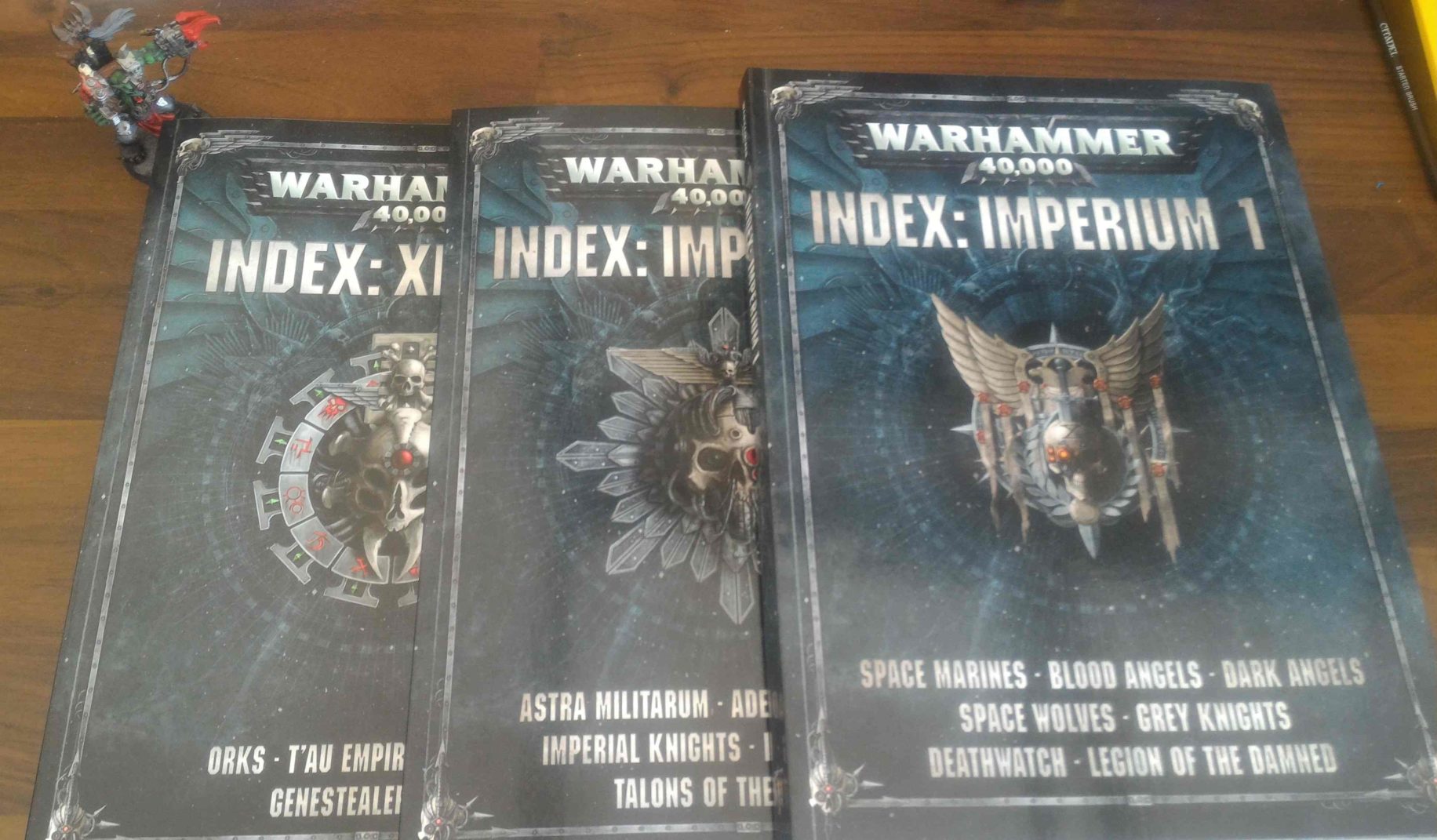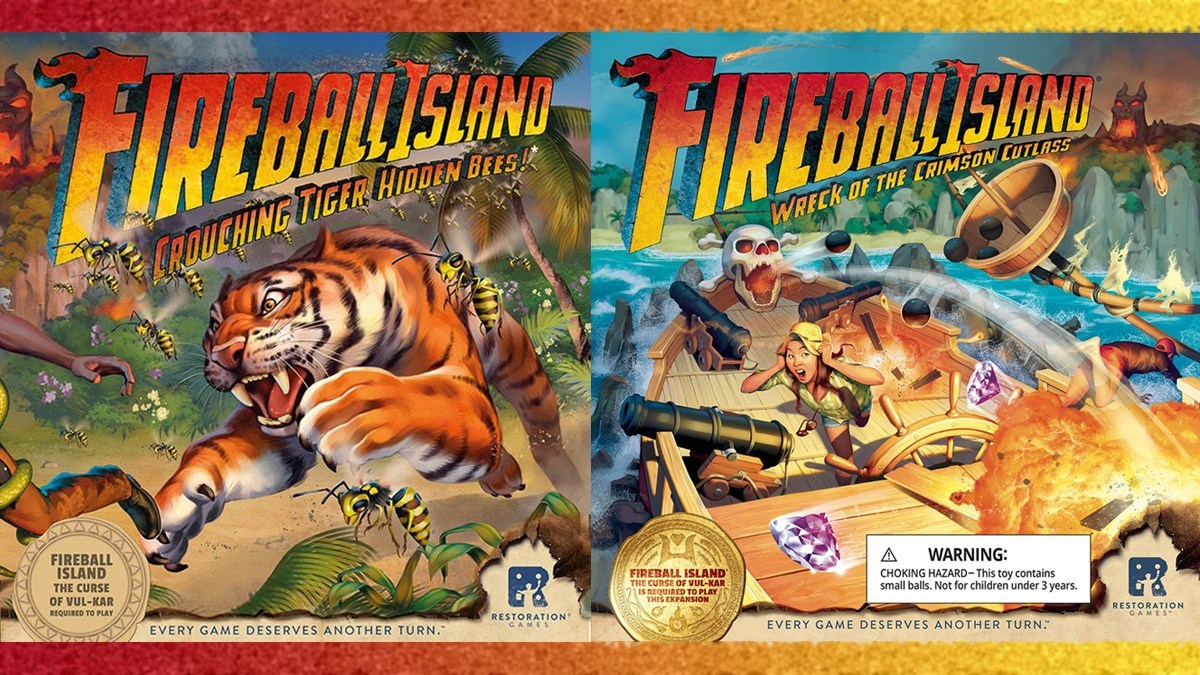What are the Warhammer 40,000 indexes?
The indexes are five new books release to coincide with Warhammer 40,000: Dark Imperium (8th Ed). They contain the rules for all of the Citadel miniatures available at the time Dark Imperium was released. They’re Games Workshop’s way of ensuring that everybody already playing the game could keep going using pretty much only the Core Rules, which are freely available.
The 5 books are broadly split into 3 types: Imperium, Xenos, and Chaos. They’re broken down as follows:
- Imperium 1 – Adeptus Astartes (Space Marines.) This book contains everything you need to know if you collect and play Space Marines. No matter what color, faction, or foible.
- Imperium 2 – Everything else that fights “For the Emperor.” So whether it’s the lowly Imperial Guard (Adeptus Militarum), the Robot workers of Mars (Adeptus Mechanicus), or the deadly Sisters of Battle (Adepta Sororitas), they are all in here. There are rules for a whole lot more besides, including those for the giant Knights. Basically, if it’s Imperial, but not a Space Marine, then it’s in this book.
- Xenos 1 – Aliens! Aeldari, Drukhari, and Necrons. AKA Space Elves and Terminators.
- Xenos 2 – More Aliens! Orks, The Tau Empire, Tyranids, and Genestealer Cults.
- Chaos: – All of the Chaos armies in one handy pestilent and world-devouring place.
The books are softback and priced at $25 each. Digital versions are also available, priced $20.
Do I need the Indexes?
The answer to this depends on your current collection. If you’re brand new to the game, and don’t have any miniatures, buy the starter box. It has everything you need to get into the Warhammer 40,000. You don’t need these indexes. All new models will come with the relevant datasheets, so you can build your army and play as you go. I’m unsure if new boxes of existing models will soon come with 8th edition datasheets, but I would hope so.
If you’re still unsure whether to enter the 41st Millennium, Games Workshop has just announced several options coming soon that are designed to appeal to new players of the game. You need to scroll down a little on that link, but do stop to marvel at the beautiful new miniatures on the way!
If you have played lots of the game in the past, you’re probably not reading these beginners posts, and already know that you need these Indexes. Whatever models you were playing with in the past, all the rules are in here.
I have figures but have never played, what should I do?
If you’re like me and have children who have loved the models for a while but are yet to play the game, you may well want to think about buying an index or two. We’ve built up quite the collection of models through the Warhammer 40,000: Battle for Vedros sets and the Build + Paint sets. These are great ways of building a miniatures collection without breaking the bank. If your 7-year-old wants to paint these in multi-colored stripes, they can. They can use them as action figures without you wincing quite so much at the cost when a plastic appendage breaks off.
If you want to convert your Vedros figures to 40K 8th Edition, then you only need Imperium 1 and Xenos 2, which will set you back $50. Not a small price, but considerably less than the $160 for the base set.

How do the Indexes reflect design decisions made in the new edition?
There are three main ways in which the new design is embodied in the Indexes: Datasheets, Power Level, and Keywords.
What is a Datasheet?
Every soldier, vehicle, and monster is represented in the new game by datasheets. They contain everything you need to play a particular model in a game. All the characteristics, weapon options, and special rules are here. The video below contains a quick overview of a datasheet.
What is Power Level?
For beginners and people playing casual games, the designers have introduced Power Level. This is roughly a scale of 1-25 that measures how powerful a model is. The higher the number the more powerful the miniature (or unit) is in the game. For units, the Power Level pertains to the number of miniatures given on the datasheet. For example, 5 Marines or 10 Orc Boyz both have a Power Level of 5 and are roughly equal to each other.
This offers a great way to throw armies together and see how powerful they are relative to one another. It’s a good way to pick up the game and play. As you progress to more formal competition games, you may want to start using points values. Points values are included in the back of the indexes for when you need them, but for beginners Power Level is fine. This new edition has been designed with ease of access in mind.
What are Keywords?
Keywords are broad categories that tie types of unit together. For example, “Character” or “Infantry.” Game rules then refer to keywords for their effects, e.g. “May target Characters” or “Hits all Infantry.” From an army-building perspective, a keyword is significant because units in an army must share at least one Faction keyword. (Faction keywords being a subset of all the more general keywords.)
This is great for anybody with Imperium forces. The “Imperium” Faction keyword appears across the two Imperium books. In older editions of the game, which Imperial units could fight alongside one another was strangely restrictive. Now, as long as they have at least one common keyword, you can band them together. This is great for building an army as it gives Imperial players a little more flexibility to choose the units they like the look of.
Players of other races don’t fair so well. There are fewer combinations allowed, though the Chaos keyword reaches across all of the Chaos Index and all Aeldari factions can be fielded together. Tyranids and Genestealer Cults can also be combined, giving a great opportunity to sport a truly monstrous army.
The synergies and combinations the keyword system offers make the game more friendly to casual players and those who like to build and paint. It also gives players more reasons to explore the Games Workshop figure range, which should lead to more sales. Keywords are win-win.

Can I play with just minis, Indexes, and the core rules?
You’ve got figures, you’ve got the right Indexes, and you’ve got the core rules. Is that everything? Well, yes and no. Strictly, yes. In reality, no, though you could manage in the short term. What’s missing? Missions.
Games are of Warhammer 40,000 are not meant to be played as pitched battles–two armies against one another until one has been crushed beneath the heels of the other. You can play it like this, but it’s not the most interesting way to do it. In its simplest form, a mission adds objectives for the armies to battle over and capture. Neither the core rules nor the Indexes have any missions. The only way to obtain these (at the moment) is to buy the full rulebook. Which is a not insignificant investment. (EDIT: This is in fact not the case. Whilst the printed core rules don’t have the Only War mission, the pdf version of the Battle Primer does.)
You can set up a basic mission, one that will suit newcomers, very easily. This will work for a decent number of games whilst you’re learning how to play.
- First, divide your gaming table lengthways down the middle to give two opposing sides.
- Place some scenery on it. For early games, this can really be anything (LEGO is great in the absence of anything else), but games are more interesting with stuff to hide behind.
- Next, choose four objective markers. These can anything from small scenery objects or plain flat discs such as poker chips.
- Each player places two markers. They can be anywhere on the board but cannot be closer than 9″ to another marker.
- Players take turns to deploy their units, one at a time.
- From the center line, measure 12 inches in both directions to form a band across the middle of the table 24″ wide. No models can be deployed inside this band. You may want to increase the depth of the band if your board is particularly wide. (As a rule of thumb, deployment shouldn’t be more than 12″ from your own table edge.)
- Determine Power Level (see above). Whoever has the lowest Power Level chooses who goes first.
- The battle lasts up to 5 rounds (each consisting of a turn for each player). Whoever holds the most objectives wins. If it is a tie, whoever has held the objectives for the most rounds wins.
And that is a very simple Warhammer 40,000 mission. As you grow in confidence, you can easily modify it if you can’t afford to shell out for new books or you’d rather spend your money on more plastic! You can also buy Tactical Objective Cards, which can be utilized in-game to suddenly change battlefield priorities. These, at $12.50, are an attractive prospect for adding variation to your games, but I’ve never used them, so I would recommend checking them out before purchasing.
How does Battle for Vedros convert to Warhammer 40,000 8th Edition?
If you have the Battle for Vedros base set, here’s how it breaks down for 8th Edition.
Space Marines:
- Captain – 5 Power Points
- Tactical Squad – 5 Power Points (4 Marines and 1 Sergeant)
- Dreadnought – 7 Power Points
- 1 Missile Launcher – 1 Power Point (Unit of 5 costs 5)
- 1 Space Marine with Flamer – 1 Power Point
- 1 Terminator Marines – 2 Power Points (approx based on price of a unit of 5)
- Total – 21 Power Points
Orks:
- Warboss in Mega Armour – 7 Power Points
- 12 Boyz – 6 Power Points (including 1 Boss Nob)
- 5 Nobz – 11 Power Points (Including 1 Boss Nob)
- 1 Deffkopta – 5 Power Points
- Total – 29 Power Points
If you use the base box only, the Orks will have an advantage, so you may need to tinker a little bit, but play a game and see how it goes! If you have other models from Vedros or Build and Paint, you can add those in too, changing the makeup of each side for each battle. You could even substitute your models for some other units. For example, running your Space Marines as if they plasma guns.
If you have a fair size collection of minis, then running games with a basic scenario and objectives and the relevant indexes are a great way to feel your way into the game. Much is made in various gaming forums of running legal armies and conforming to the mission forms, but I learned to play these games before all that existed. Today’s stronger framework is great, but never underestimate the power of enthusiasm, imagination, and getting stuck in.
Disclaimer: I was sent the Indexes for review purposes.


The story is very interesting and interesting, with this book I think it suits everyone